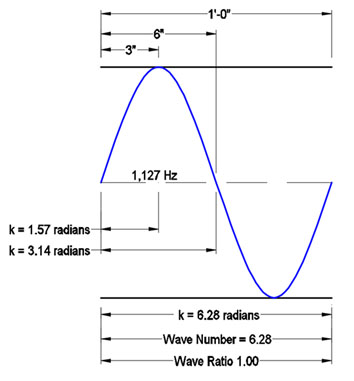The Wave Number (k) Formula:
The formula is: k = 2 * π * f/c
k is the Wave Number
π represents pi, or 3.14
f stands for the frequency being evaluated
c is the speed of sound
The result of the k formula gives us a number that is expressed in inverse feet when the last element of the sequence “c” is applied. This step divides the product of the initial sequence of elements (2 * π * f ), by the speed of sound; so as the frequency increases, so too does the wave number.
Examples: The wave number (k) of 1 kHz is 5.57. The formula looks like this: 2 * 3.14 * 1,000/1,127 = 5.57. And, because 2 * 3.14 is always 6.28, we can further simplify the formula like this: 6.28 * 2,000/1,127 = 11.14, which is the wave number for 2 kHz.
If you’re with me so far you’ve just learned a bit of trigonometry. Trig lets us stretch out the curves of a sine wave and measure the circumferential length of one cycle for any given frequency. Also notice: As the frequency doubles or halves, so does the k number.
Finding the inverse of a frequency’s wavelength is useful too, because it tells us what percentage of the wavelength fits into one linear foot.
To get the inverse number of a frequency, the wavelength in question is divided into 1. The formula for 1 kHz looks like this: 1/1.127 = 0.89. Remember, the period of a 1 kHz wave is 1.127’. The answer (0.89) means that in the distance of 1′, only 0.89 or 89% of one full 1 kHz sine wave can be completed.
Unfortunately, the k number alone doesn’t give us everything we need to know. The number is important, but it’s merely the first step towards reaching the “ka” enlightenment. Sorry, couldn’t resist.
What Is ka?
ka (all lower case) is a non-dimensional combination of two factors that are multiplied in a simple equation: k * a
Finding k has been established above. The “a” is the factor that represents the significant physical dimension of the object that’s blocking the sound wave(s) in question. The emphasis on the word significant is placed to draw attention to the most problematic (or useful) dimension of an obstruction.
Significant Dimension (SigDim)
The phrase “significant dimension” is used often in this paper, and will be shortened to SigDim(s) from this point forward. And please take note, all SigDims must be converted from inches to decimal feet.
What is a SigDim and what are the relevant frequencies affected by any specific obstruction?
Sound obstructions come in many forms. Some common examples are structural columns, chandeliers, catwalks, roof trusses and soffits, ceiling fans, and architectural and theatrical lighting fixtures. Evaluating each of these to determine its SigDim is a fairly straight-forward process of determining which dimension is most problematic for the person sitting behind the impediment.





